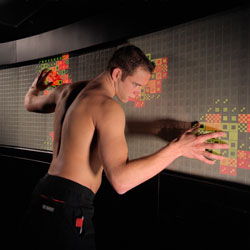The Quest for Novel Computational Paradigms and Machines
by Christof Teuscher
The quest for novel and unconventional computing machines is mainly motivated by the man-machine dichotomy and by the belief that meeting tomorrow's complex real world challenges will require new paradigms and new engineering methods to organize, train, and program such machines and to interact with them.
Ever wondered how tomorrow's computers might look like? Ever wished scientists and engineers would come up with smarter, more robust, and more autonomous computers able to reliably operate in and adapt to their complex and unpredictable natural environments? Well, that's what my and many other researcher's work is focused on!
|
At the time of Alan Turing, computing machines were merely considered as devices capable of doing what the human mind can do when carrying out a procedure. Turing's hope that "[...] machines will eventually compete with men in all purely intellectual fields" is far from being fulfilled and the man-machine dichotomy remains more than obvious. For example, one of the keys to machine intelligence is computers that learn in an open and unrestricted way, and we are still just scratching the surface of this problem. Something must be wrong!
Although there is no reason and evidence to believe that any physical system, including the brain, can perform computations a computer cannot, there is a growing interest in computational architectures that go beyond the classical paradigms and that offer novel properties. For example, many man-made systems have become so complex that they are virtually uncontrollable and incomprehensible: self-design, self-adaptation, self-diagnosis, and self-repair will become of paramount importance.
The research community investigates novel computational paradigms along several directions and on various different levels. My own research is influenced by a number of principal insights. First, I believe that we have to go beyond the omnipresent sequential paradigms in computer science if we want to come closer to machines with properties and architectures similar to the brain. However, it is not my goal to 'copy' nature but only to draw valuable inspiration from it and to apply adapted paradigms to the design of artefacts. Second, novel approaches have to be integrative, all-embracing, and should start at the level of the computational substrate. Simulating a parallel machine on a sequential computer might be practical, but is certainly not efficient and by no means a scalable approach. Third, the capacity to adapt and learn should go in hand with the capacity to gradually create more complex and hierarchical systems, as I believe that our abilities to program complex systems are simply not keeping up with the desire to solve complex problems.
The Logic Systems Laboratory at the Swiss Federal Institute of Technology in Lausanne (EPFL) was a pioneer in biologically-inspired computing machines and hardware. For my PhD thesis, I investigated an unconventional reconfigurable architecture that is based on an amalgamation of a particle-based and randomly interconnected substrate, membrane systems, and artificial chemistries in combination with an unconventional adaptation paradigm.
The proposed reconfigurable architecture relies on a simple, irregular, inhomogeneous, locally interconnected, asynchronously operating, and imperfect particle-based substrate, not unlike an amorphous computer. However, communications are wire-based and the main part of each particle consists of a reactor for artificial chemistries. The only way to build a perfect machine out of imperfect components is to make use of redundant spare components and therefore a fine-grained particle-based implementation is beneficial. Scalability is assured by avoiding central control and by using local interactions only. An additional goal was to make the basic hardware component as simple and universal as possible. The creation of hierarchical organizations was inspired by biological membranes and membrane systems (P systems). Artificial chemistries represent, if appropriately used, an ideal means to compute in uncertain environments. We made extensive use of that unconventional form of computation as it has also been identified as potentially promising for the perpetual creation of novelty, a feature that was used for our adaptation paradigm called membrane blending. Blending (or conceptual integration) is a framework of cognitive science that tries to explain how we think and deal with mental concepts. However, instead of dealing with concepts, we draw inspiration from this framework and applied it to artificial chemistries and membrane systems.
This experimental architecture represents one step towards novel and unconventional machines and is part of the general scientific challenge of seeking for further progress and new metaphors in computer science. Although a lot remains to be done and competitive real world applications for such machines are likely to be several years away, it is crucial to start developing novel mechanisms which will ultimately help us to make machines more scalable, more robust, smarter, and more 'self-everything' in general.
Future work will be focused on further refining and improving the proposed concepts and investigating their interesting properties. The gradual creation of complex, hierarchically organized systems by means of chemical blending and the investigation of large chemical reactor network dynamics are of particular interest. Ultimately, the aim is to come up with a radically new reconfigurable architecture for adaptive systems that is fully competitive with classical, regularly interconnected and arranged Field Programmable Gate Arrays (FPGAs).
There are many further research opportunities in this exciting field. As Alan Kay put it: "The computer revolution hasn't happened yet!"
Christof Teuscher is the winner of the ERCIM 2004 Cor Baayen award.
Links:
BioWall: http://lslwww.epfl.ch/biowall
POEtic tissue: http://www.poetictissue.org
BLOB Computing: http://blob.lri.fr
Amorphous Computing: http://www.swiss.ai.mit.edu/projects/amorphous
Blending: http://blending.stanford.edu
Membrane Systems: http://psystems.disco.unimib.it
Please contact:
Christof Teuscher
University of California, San Diego (UCSD)
E-mail: christof![]() teuscher.ch
teuscher.ch
http://www.teuscher.ch/christof

 This issue in
This issue in 
